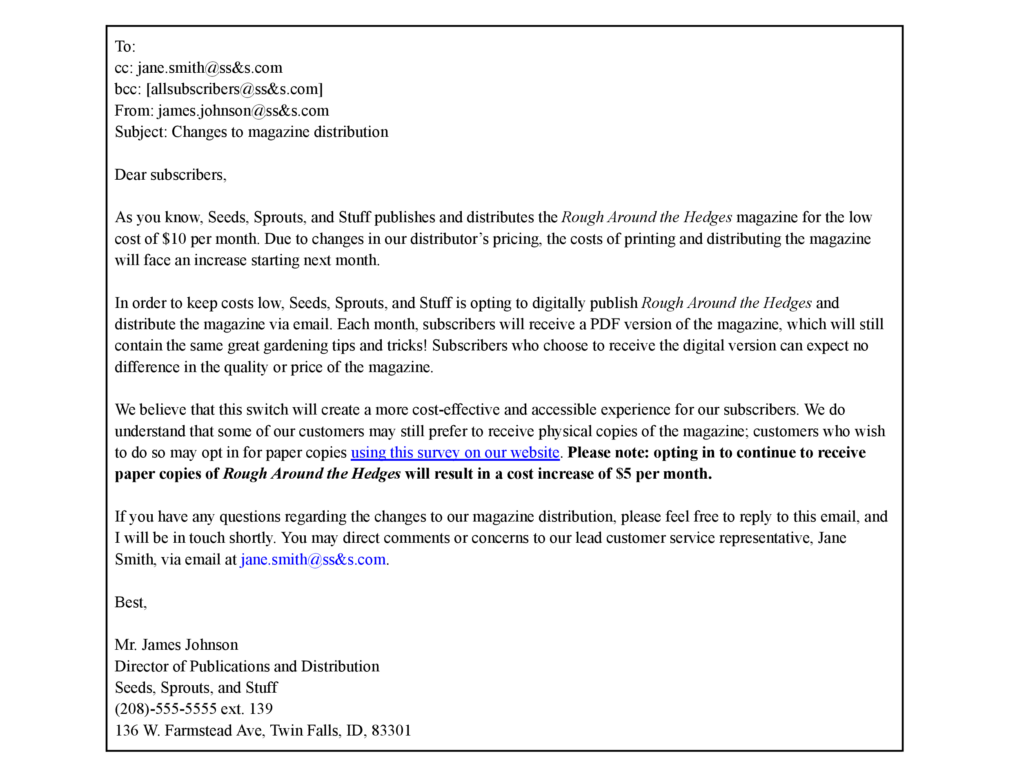Click here to download a .pdf of our Professional Email Guide!
Last updated: October 7, 2023
Consider keeping a printed copy to have when writing and revising your resume! If you have any additional questions, make an appointment or email us at writing@boisestate.edu!
Writing a Professional Email
The ability to communicate messages in a professional and concise way over email is highly valued in many academic and professional settings. While the nature of the message will determine how the writer will organize the email, there are a few things to keep in mind no matter what type of message you are trying to deliver. The provided example demonstrates some key characteristics of professional emails.

Quick Guide to Professional Emails
1. Key terms to know.
- Carbon copy (CC) – The “cc” line is not typically addressed to the audience; instead, it is addressed to any party(s) who need to be aware of the contents of the email when there’s no need to keep their address confidential. In the provided example, Jane Smith is identified in the last paragraph of the email as a potential contact for concerned customers, so she would need to be aware of the email’s contents.
- Blind carbon copy (BCC) – The “bcc” line keeps mass email lists confidential and limits the “reply all” function. For example, if a customer hits “reply ally” on the example email, it would only send their reply to James and Jane, not to the whole list of customers who originally received the email.
2. Elements of an email.
Subject line:
Offer a brief and specific subject line that includes keywords about the topic of the email. (e.g. Subject: How to write a professional email)
Greeting or salutation:
An effective salutation should address the specific recipient(s), professionally and friendly. Avoid assigning gendered pronouns or honorifics unless known. When in doubt, “mirror” what another person calls themselves (or how they sign their emails) to respect their identity.
Body paragraphs:
Keep it short and professional; emails are concise. Paragraphs in an email will usually not exceed four to five sentences. Each sentence should serve a specific purpose. The tone, no matter the message, should highlight the positive attributes of news delivered with a future-oriented attitude. Be mindful not to ignore bad news. The goal is to avoid halting conversation and instead invite ways to move forward.
Format:
Emails are typically formatted in block format: the entire message is left justified, single spaced except for an added space between paragraphs, with no extra indentation for paragraphs. White space (blank white space on the page) such as the extra spacing between paragraphs helps with readability!
Headings
Headings within an email create visual order as a means of organization. They may be used to separate ideas, and may include elements such as bulleted lists (as seen in “Key Terms to Know”).
Closing:
Finish the email with a respectful closing to leave a final impression on the recipient. Include any call-to-action, or next steps, for the recipient to take. Finish with a closing salutation, such as: Best, Sincerely, Kindly, Thank you for reading, Looking forward to meeting, Please contact me for additional help, Regards, or Warm regard.
Email signature:
Include your name at the very minimum. If the email signature is specific to you (and not written on behalf of a company), include information about your position and qualifications. The typical order for this is:
- Your name (and pronouns) – Include your name (and pronouns in parentheses) e.g. James Johnson (he/him).
- Your position(s) or title(s) – Positions or titles held, such as Director of Publications and Distributions.
- Company or group name – e.g. Seeds, Sprouts, and Stuff or Boise State University.
- Phone number and or email address – List your preferred professional contact method(s).
- Mailing address – If relevant, include your mailing address (such as for letters or returns).